Demon
A demon is a supernatural being, typically associated with evil, prevalent historically in religion, occultism, literature, fiction, mythology, and folklore; as well as in media such as comics, video games, movies, anime, and television series.
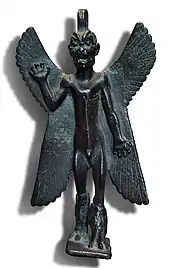
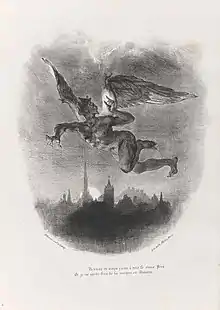
The original Greek word daimon does not carry negative connotations.[1] The Ancient Greek word δαίμων daimōn denotes a spirit or divine power, much like the Latin genius or numen.[2] The Greek conception of a daimōn notably appears in the works of Plato, where it describes the divine inspiration of Socrates.
In Ancient Near Eastern religions and in the Abrahamic traditions, including ancient and medieval Christian demonology, a demon is considered a harmful spiritual entity which may cause demonic possession, calling for an exorcism. In Western occultism and Renaissance magic, which grew out of an amalgamation of Greco-Roman magic, Jewish Aggadah and Christian demonology,[3] a demon is believed to be a spiritual entity that may be conjured and controlled.
Etymology
The Ancient Greek word δαίμων daemon denotes a spirit or divine power, much like the Latin genius or numen. Daimōn most likely came from the Greek verb daiesthai (to divide, distribute).[2] The Greek conception of a daimōn notably appears in the works of Plato, where it describes the divine inspiration of Socrates. The original Greek word daimon does not carry the negative connotation initially understood by implementation of the Koine δαιμόνιον (daimonion),[1] and later ascribed to any cognate words sharing the root.
The Greek terms do not have any connotations of evil or malevolence. In fact, εὐδαιμονία eudaimonia, (literally good-spiritedness) means happiness. By the early Roman Empire, cult statues were seen, by pagans and their Christian neighbors alike, as inhabited by the numinous presence of the gods: "Like pagans, Christians still sensed and saw the gods and their power, and as something, they had to assume, lay behind it, by an easy traditional shift of opinion they turned these pagan daimones into malevolent 'demons', the troupe of Satan..... Far into the Byzantine period Christians eyed their cities' old pagan statuary as a seat of the demons' presence. It was no longer beautiful, it was infested."[4] The term had first acquired its negative connotations in the Septuagint translation of the Hebrew Bible into Greek, which drew on the mythology of ancient Semitic religions. This was then inherited by the Koine text of the New Testament. The Western medieval and neo-medieval conception of a demon[5] derives seamlessly from the ambient popular culture of Late Antiquity. The Hellenistic "daemon" eventually came to include many Semitic and Near Eastern gods as evaluated by Christianity.
The supposed existence of demons remains an important concept in many modern religions and occultist traditions. Demons are still feared largely due to their alleged power to possess living creatures. In the contemporary Western occultist tradition (perhaps epitomized by the work of Aleister Crowley), a demon (such as Choronzon, which is Crowley's interpretation of the so-called 'Demon of the Abyss') is a useful metaphor for certain inner psychological processes (inner demons), though some may also regard it as an objectively real phenomenon. Some scholars[6] believe that large portions of the demonology (see Asmodai) of Judaism, a key influence on Christianity and Islam, originated from a later form of Zoroastrianism, and were transferred to Judaism during the Persian era.
Ancient Egypt
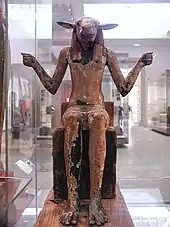
Both deities and demons can act as intermediaries to deliver messages to humans.[7] Thus they share some resemblance to the Greek daimonion. The exact definition of "demon" in Egyptology posed a major problem for modern scholarship, since the borders between a deity and a demon are sometimes blurred and the ancient Egyptian language lacks a term for the modern English "demon".[8][9] However, magical writings indicate that ancient Egyptians acknowledged the existence of malevolent demons by highlighting the demon names with red ink.[9] Demons in this culture appeared to be subordinative and related to a specific deity, yet they may have occasionally acted independently of the divine will. The existence of demons can be related to the realm of chaos, beyond the created world.[8] But even this negative connotation cannot be denied in light of the magical texts. The role of demons in relation to the human world remains ambivalent and largely depends on context.
Ancient Egyptian demons can be divided into two classes: "guardians" and "wanderers."[10][11] "Guardians" are tied to a specific place; their demonic activity is topographically defined and their function can be benevolent towards those who have the secret knowledge to face them.[12] Demons protecting the underworld may prevent human souls from entering paradise. Only by knowing right charms is the deceased able to enter the Halls of Osiris.[13] Here, the aggressive nature of the guardian demons is motivated by the need to protect their abodes and not by their evil essence. Accordingly, demons guarded sacred places or the gates to the netherworld. During the Ptolemaic and Roman period, the guardians shifted towards the role of Genius loci and they were the focus of local and private cults.
The "wanderers" are associated with possession, mental illness, death and plagues. Many of them serve as executioners for the major deities, such as Ra or Osiris, when ordered to punish humans on earth or in the netherworld.[12] Wanderers can also be agents of chaos, arising from the world beyond creation to bring about misfortune and suffering without any divine instructions, led only by evil motivations. The influences of the wanderers can be warded off and kept at the borders on the human world by the use of magic, but they can never be destroyed. A sub-category of "wanderers" are nightmare demons, which were believed to cause nightmares by entering a human body.[8]
Mesopotamia
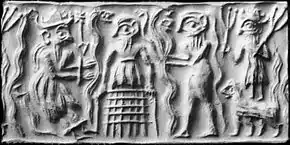
The ancient Mesopotamians believed that the underworld was home to many demons,[14] which are sometimes referred to as "offspring of arali".[14] These demons could sometimes leave the underworld and terrorize mortals on earth.[14] One class of demons that were believed to reside in the underworld were known as galla;[15] their primary purpose appears to have been to drag unfortunate mortals back to Kur.[15] They are frequently referenced in magical texts,[16] and some texts describe them as being seven in number.[16] Several extant poems describe the galla dragging the god Dumuzid into the underworld.[17] Like other demons, however, galla could also be benevolent[17] and, in a hymn from King Gudea of Lagash (c. 2144 – 2124 BCE), a minor god named Ig-alima is described as "the great galla of Girsu".[17]
Lamashtu was a demonic goddess with the "head of a lion, the teeth of a donkey, naked breasts, a hairy body, hands stained (with blood?), long fingers and fingernails, and the feet of Anzû."[18] She was believed to feed on the blood of human infants[18] and was widely blamed as the cause of miscarriages and cot deaths.[18] Although Lamashtu has traditionally been identified as a demoness,[19] the fact that she could cause evil on her own without the permission of other deities strongly indicates that she was seen as a goddess in her own right.[18] Mesopotamian peoples protected against her using amulets and talismans.[18] She was believed to ride in her boat on the river of the underworld[18] and she was associated with donkeys.[18] She was believed to be the daughter of An.[18]
Pazuzu is a demonic god who was well known to the Babylonians and Assyrians throughout the first millennium BCE.[20] He is shown with "a rather canine face with abnormally bulging eyes, a scaly body, a snake-headed penis, the talons of a bird and usually wings."[20] He was believed to be the son of the god Hanbi.[21] He was usually regarded as evil,[20] but he could also sometimes be a beneficent entity who protected against winds bearing pestilence[20] and he was thought to be able to force Lamashtu back to the underworld.[22] Amulets bearing his image were positioned in dwellings to protect infants from Lamashtu[21] and pregnant women frequently wore amulets with his head on them as protection from her.[21]
Šul-pa-e's name means "youthful brilliance", but he was not envisioned as youthful god.[23] According to one tradition, he was the consort of Ninhursag, a tradition which contradicts the usual portrayal of Enki as Ninhursag's consort.[23][24] In one Sumerian poem, offerings made to Šhul-pa-e in the underworld and, in later mythology, he was one of the demons of the underworld.[23]
According to the Jewish Encyclopedia, "In Chaldean mythology the seven evil deities were known as shedu, storm-demons, represented in ox-like form."[25] They were represented as winged bulls, derived from the colossal bulls used as protective jinn of royal palaces.[26]
Abrahamic religions
Judaism
.jpg.webp)
As referring to the existence or non-existence of demons (shedim or Se'irim) there are converse opinions in Judaism.[25] There are "practically nil" roles assigned to demons in the Hebrew Bible.[27] In Judaism today, beliefs in "demons" or "evil spirits" are either midot hasidut (Hebr. for "customs of the pious"), and therefore not halachah, or notions based on a superstition that are non-essential, non-binding parts of Judaism, and therefore not normative Jewish practice. That is to say, Jews are not obligated to believe in the existence of shedim, as posek rabbi David Bar-Hayim points out.[28]
Tanakh
The Tanakh mentions two classes of demonic spirits, the se'irim and the shedim. The word shedim appears in two places in the Tanakh (Psalm 106:37, Deuteronomy 32:17). The se'irim are mentioned once in Leviticus 17:7,[29] probably a re-calling of Assyrian demons in shape of goats.[30] The shedim in return are not pagan demigods, but the foreign gods themselves. Both entities appear in a scriptural context of animal or child sacrifice to "non-existent" false gods.[25][27][31]
From Chaldea, the term shedu traveled to the Israelites. The writers of the Tanach applied the word as a dialogism to Canaanite deities.
There are indications that demons in popular Hebrew mythology were believed to come from the nether world.[32] Various diseases and ailments were ascribed to them, particularly those affecting the brain and those of internal nature. Examples include catalepsy, headache, epilepsy and nightmares. There also existed a demon of blindness, "Shabriri" (lit. "dazzling glare") who rested on uncovered water at night and blinded those who drank from it.[33]
Demons supposedly entered the body and caused the disease while overwhelming or "seizing" the victim. To cure such diseases, it was necessary to draw out the evil demons by certain incantations and talismanic performances, at which the Essenes excelled.[25] Josephus, who spoke of demons as "spirits of the wicked which enter into men that are alive and kill them", but which could be driven out by a certain root,[34] witnessed such a performance in the presence of the Emperor Vespasian[35] and ascribed its origin to King Solomon. In mythology, there were few defences against Babylonian demons. The mythical mace Sharur had the power to slay demons such as Asag, a legendary gallu or edimmu of hideous strength.
Second Temple period texts
To the Qumran community during the Second Temple period this apotropaic prayer was assigned, stating: "And, I the Sage, declare the grandeur of his radiance in order to frighten and terri[fy] all the spirits of the ravaging angels and the bastard spirits, demons, Liliths, owls" (Dead Sea Scrolls, "Songs of the Sage," Lines 4–5).[36][37]
In the Dead Sea Scrolls, there exists a fragment entitled "Curses of Belial" (Curses of Belial (Dead Sea Scrolls, 394, 4Q286(4Q287, fr. 6)=4QBerakhot)). This fragment holds much rich language that reflects the sentiment shared between the Qumran towards Belial. In many ways this text shows how these people thought Belial influenced sin through the way they address him and speak of him. By addressing "Belial and all his guilty lot," (4Q286:2) they make it clear that he is not only impious, but also guilty of sins. Informing this state of uncleanliness are both his "hostile" and "wicked design" (4Q286:3,4). Through this design, Belial poisons the thoughts of those who are not necessarily sinners. Thus a dualism is born from those inclined to be wicked and those who aren't.[38] It is clear that Belial directly influences sin by the mention of "abominable plots" and "guilty inclination" (4Q286:8,9). These are both mechanisms by which Belial advances his evil agenda that the Qumran have exposed and are calling upon God to protect them from. There is a deep sense of fear that Belial will "establish in their heart their evil devices" (4Q286:11,12). This sense of fear is the stimulus for this prayer in the first place. Without the worry and potential of falling victim to Belial's demonic sway, the Qumran people would never feel impelled to craft a curse. This very fact illuminates the power Belial was believed to hold over mortals, and the fact that sin proved to be a temptation that must stem from an impure origin.
In Jubilees 1:20, Belial's appearance continues to support the notion that sin is a direct product of his influence. Moreover, Belial's presence acts as a placeholder for all negative influences or those that would potentially interfere with God's will and a pious existence. Similarly to the "gentiles ... [who] cause them to sin against you" (Jubilees 1:19), Belial is associated with a force that drives one away from God. Coupled in this plea for protection against foreign rule, in this case the Egyptians, is a plea for protection from "the spirit of Belial" (Jubilees 1:19). Belial's tendency is to "ensnare [you] from every path of righteousness" (Jubilees 1:19). This phrase is intentionally vague, allowing room for interpretation. Everyone, in one way or another, finds themselves straying from the path of righteousness and by pawning this transgression off on Belial, he becomes a scapegoat for all misguidance, no matter what the cause. By associating Belial with all sorts of misfortune and negative external influence, the Qumran people are henceforth allowed to be let off for the sins they commit.
Belial's presence is found throughout the War Scrolls, located in the Dead Sea Scrolls, and is established as the force occupying the opposite end of the spectrum of God. In Col. I, verse 1, the first line of the document, it is stated that "the first attack of the Sons of Light shall be undertaken against the forces of the Sons of Darkness, the army of Belial" (1Q33;1:1).[39] This dichotomy sheds light on the negative connotations that Belial held at the time.[40] Where God and his Sons of Light are forces that protect and promote piety, Belial and his Sons of Darkness cater to the opposite, instilling the desire to sin and encouraging destruction. This opposition is only reinforced later in the document; it continues to read that the "holy ones" will "strike a blow at wickedness", ultimately resulting in the "annihilation of the Sons of Darkness" (1Q33:1:13). This epic battle between good and evil described in such abstract terms, however it is also applicable to everyday life and serves as a lens through which the Qumran see the world. Every day is the Sons of Light battle evil and call upon God to help them overcome evil in ways small and large.
Belial's influence is not taken lightly. In Col. XI, verse 8, the text depicts God conquering the "hordes of Belial" (1Q33;11:8). This defeat is indicative of God's power over Belial and his forces of temptation. However the fact that Belial is the leader of hordes is a testament to how persuasive he can be. If Belial was obviously an arbiter of wrongdoing and was blatantly in the wrong, he wouldn't be able to amass an army. This fact serves as a warning message, reasserting God's strength, while also making it extremely clear the breadth of Belial's prowess. Belial's "council is to condemn and convict", so the Qumran feel strongly that their people are not only aware of his purpose, but also equipped to combat his influence (1Q33;13:11).
In the Damascus Document, Belial also makes a prominent appearance, being established as a source of evil and an origin of several types of sin. In Column 4, the first mention of Belial reads: "Belial shall be unleashed against Israel" (4Q266). This phrase is able to be interpreted myriad different ways. Belial is characterized in a wild and uncontrollable fashion, making him seem more dangerous and unpredictable. The notion of being unleashed is such that once he is free to roam; he is unstoppable and able to carry out his agenda uninhibited. The passage then goes to enumerate the "three nets" (4Q266;4:16) by which Belial captures his prey and forces them to sin. "Fornication ..., riches ..., [and] the profanation of the temple" (4Q266;4:17,18) make up the three nets. These three temptations were three agents by which people were driven to sin, so subsequently, the Qumran people crafted the nets of Belial to rationalize why these specific temptations were so toxic. Later in Column 5, Belial is mentioned again as one of "the removers of bound who led Israel astray" (4Q266;5:20). This statement is a clear display of Belial's influence over man regarding sin. The passage goes on to state: "they preached rebellion against ... God" (4Q266;5:21,22). Belial's purpose is to undermine the teachings of God, and he achieves this by imparting his nets on humans, or the incentive to sin.[41]
In the War of the Sons of Light Against the Sons of Darkness, Belial controls scores of demons, which are specifically allotted to him by God for the purpose of performing evil.[42] Belial, despite his malevolent disposition, is considered an angel.[43]
Talmudic tradition
In the Jerusalem Talmud notions of shedim ("demons" or "spirits") are almost unknown or occur only very rarely, whereas in the Babylon Talmud there are many references to shedim and magical incantations. The existence of shedim in general was not questioned by most of the Babylonian Talmudists. As a consequence of the rise of influence of the Babylonian Talmud over that of the Jerusalem Talmud, late rabbis in general took as fact the existence of shedim, nor did most of the medieval thinkers question their reality. However, rationalists like Maimonides, Saadia Gaon and Abraham ibn Ezra and others explicitly denied their existence, and completely rejected concepts of demons, evil spirits, negative spiritual influences, attaching and possessing spirits. Their point of view eventually became mainstream Jewish understanding.[25][44]
Kabbalah
In Kabbalah demons are regarded a necessary part of the divine emanation in the material world and a byproduct of human sin (Qliphoth).[45] However spirits such as the shedim may also be benevolent and were used in kabbalistic ceremonies (as with the golem of Rabbi Yehuda Loevy) and malevolent shedim (Mazikin, from the root meaning "to damage") were often credited with possession.[46]
Aggadah
Aggadic tales from the Persian tradition describe the shedim, the mazziḳim ("harmers"), and the ruḥin ("spirits"). There were also lilin ("night spirits"), ṭelane ("shade", or "evening spirits"), ṭiharire ("midday spirits"), and ẓafrire ("morning spirits"), as well as the "demons that bring famine" and "such as cause storm and earthquake".[47][25] According to some aggadic stories, demons were under the dominion of a king or chief, either Asmodai[48] or, in the older Aggadah, Samael ("the angel of death"), who killed via poison. Stories in the fashion of this kind of folklore never became an essential feature of Jewish theology.[44] Although occasionally an angel is called satan in the Babylon Talmud, this does not refer to a demon: "Stand not in the way of an ox when coming from the pasture, for Satan dances between his horns".[49]
Old Testament
Demonic entities in the Old Testament of the Christian Bible are of two classes: the "satyrs" or "shaggy goats" (from Hebr. se'irim "hairy beings", "he-goats" or "fauns"; Isaiah 13:21, 34:14)[50] and the "demons" (from Hebr. shedim first translated as Greek: δαιμόνιον daimonion, "daemon"; 106:35–39, 32:17).
New Testament
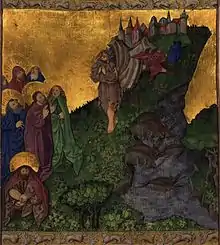
The term demon (from the Koine Greek δαιμόνιον daimonion) appears 63 times in the New Testament of the Christian Bible, mostly if not all relating to occurrences of possession of individuals and exorcism by Jesus.[51][52][53]
The King James Version kept it translated as devil. The word devil by itself is the translation word for the Greek diabolos which occurs 38 times in the New Testament. The Tyndale Bible (1526 CE), a precursor of KJV, translated it all as devyl, including Act 17:18 as newe devyls.
Pseudepigrapha and deuterocanonical books
Demons are included into biblical interpretation. In the story of Passover, the Bible tells the story as "the Lord struck down all the firstborn in Egypt" (Exodus 12:21–29). In the Book of Jubilees, which is considered canonical only by the Ethiopian Orthodox Church,[54] this same event is told slightly differently: "All the powers of [the demon] Mastema had been let loose to slay all the first-born in the land of Egypt...And the powers of the Lord did everything according as the Lord commanded them" (Jubilees 49:2–4).
In the Genesis flood narrative the author explains how God was noticing "how corrupt the earth had become, for all the people on earth had corrupted their ways" (Genesis 6:12). In Jubilees the sins of man are attributed to "the unclean demons [who] began to lead astray the children of the sons of Noah, and to make to err and destroy them" (Jubilees 10:1). In Jubilees Mastema questions the loyalty of Abraham and tells God to "bid him offer him as a burnt offering on the altar, and Thou wilt see if he will do this command" (Jubilees 17:16). The discrepancy between the story in Jubilees and the story in Genesis 22 exists with the presence of Mastema. In Genesis, God tests the will of Abraham merely to determine whether he is a true follower, however; in Jubilees Mastema has an agenda behind promoting the sacrifice of Abraham's son, "an even more demonic act than that of the Satan in Job."[55] In Jubilees, where Mastema, an angel tasked with the tempting of mortals into sin and iniquity, requests that God give him a tenth of the spirits of the children of the watchers, demons, in order to aid the process.[56] These demons are passed into Mastema's authority, where once again, an angel is in charge of demonic spirits.

The sources of demonic influence were thought to originate from the Watchers or Nephilim, who are first mentioned in Genesis 6 and are the focus of 1 Enoch Chapters 1–16, and also in Jubilees 10. The Nephilim were seen as the source of the sin and evil on earth because they are referenced in Genesis 6:4 before the story of the Flood.[58] In Genesis 6:5, God sees evil in the hearts of men. The passage states, "the wickedness of humankind on earth was great", and that "Every inclination of the thoughts of their hearts was only continually evil" (Genesis 5). The mention of the Nephilim in the preceding sentence connects the spread of evil to the Nephilim. Enoch is a very similar story to Genesis 6:4–5, and provides further description of the story connecting the Nephilim to the corruption of humans. In Enoch, sin originates when angels descend from heaven and fornicate with women, birthing giants as tall as 300 cubits. The giants and the angels' departure of Heaven and mating with human women are also seen as the source of sorrow and sadness on Earth. The book of Enoch shows that these fallen angels can lead humans to sin through direct interaction or through providing forbidden knowledge. In Enoch, Semyaz leads the angels to mate with women. Angels mating with humans is against God's commands and is a cursed action, resulting in the wrath of God coming upon Earth. Azazel indirectly influences humans to sin by teaching them divine knowledge not meant for humans. Asael brings down the "stolen mysteries" (Enoch 16:3). Asael gives the humans weapons, which they use to kill each other. Humans are also taught other sinful actions such as beautification techniques, alchemy, astrology and how to make medicine (considered forbidden knowledge at the time). Demons originate from the evil spirits of the giants that are cursed by God to wander the earth. These spirits are stated in Enoch to "corrupt, fall, be excited, and fall upon the earth, and cause sorrow" (Enoch 15:11).[59]
The Book of Jubilees conveys that sin occurs when Cainan accidentally transcribes astrological knowledge used by the Watchers (Jubilees 8). This differs from Enoch in that it does not place blame on the Angels. However, in Jubilees 10:4 the evil spirits of the Watchers are discussed as evil and still remain on earth to corrupt the humans. God binds only 90 percent of the Watchers and destroys them, leaving 10 percent to be ruled by Mastema. Because the evil in humans is great, only 10 percent would be needed to corrupt and lead humans astray. These spirits of the giants also referred to as "the bastards" in the Apotropaic prayer Songs of the Sage, which lists the names of demons the narrator hopes to expel.[60]
Christian demonology
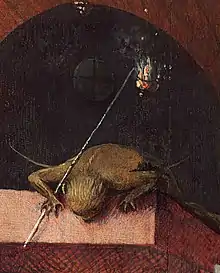
In Christianity, demons are corrupted spirits carrying the execution of Satan's desires. They are generally regarded as three different types of spirits:
- Souls of the wicked deceased, which roam the earth to torment the living.[61]
- Nephilim, who came into being by union between angels and human, but their bodily part were wiped out during the Great flood. Their spiritual part now desires reembodiment.[62][63]
- Fallen angels, who sided with Lucifer and were cast out of heaven by Michael after battle.
Often deities of other religions are interpreted or identified as such "demons" (from the Greek Old Testament δαιμόνιον daimonion).[64] The evolution of the Christian Devil and pentagram are examples of early rituals and images that showcase evil qualities, as seen by the Christian churches.
Since Early Christianity, demonology has developed from a simple acceptance of demons to a complex study that has grown from the original ideas taken from Jewish demonology and Christian scriptures.[65] Christian demonology is studied in depth within the Roman Catholic Church,[66] although many other Christian churches affirm and discuss the existence of demons.[67][68]
Building upon the few references to daemons in the New Testament, especially the poetry of the Book of Revelation, Christian writers of apocrypha from the 2nd century onwards created a more complicated tapestry of beliefs about "demons" that was largely independent of Christian scripture.
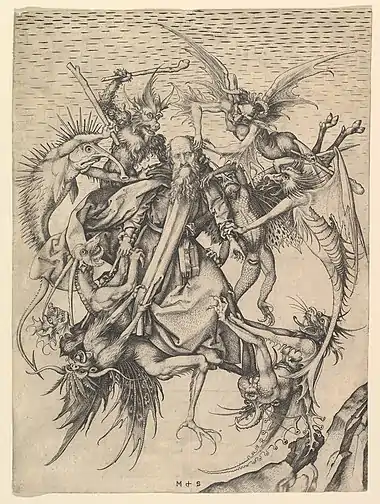
The contemporary Roman Catholic Church unequivocally teaches that angels and demons are real beings rather than just symbolic devices. The Catholic Church has a cadre of officially sanctioned exorcists which perform many exorcisms each year. The exorcists of the Catholic Church teach that demons attack humans continually but that afflicted persons can be effectively healed and protected either by the formal rite of exorcism, authorized to be performed only by bishops and those they designate, or by prayers of deliverance, which any Christian can offer for themselves or others.[69]
At various times in Christian history, attempts have been made to classify demons according to various proposed demonic hierarchies.
In the Gospels, particularly the Gospel of Mark, Jesus cast out many demons from those afflicted with various ailments. He also lent this power to some of his disciples (Luke 10:17).
Islam
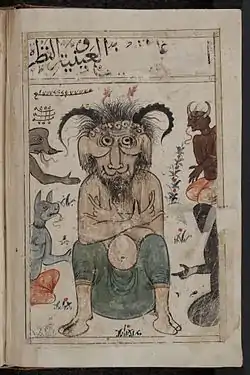
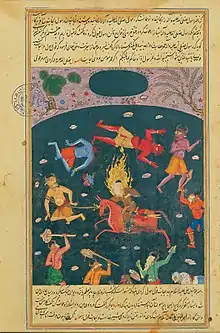
Shayatin is the usual term for demons in Islamic belief.[70] In Islam demons try to lead humans astray from God, by tempting them to sin, teaching them sorcery and cause mischief among humans. Occult practises albeit not forbidden per se, may include conjuring demons, which requires acts against God's laws and are therefore forbidden, such as illicit blood-sacrifices, abandoning prayer and rejecting fasting. Based on the Islamic view on Solomon, who is widely believed to have been a ruler over genies and demons, Islam has a rich tradition about conjuring demons. Among the demons are the shayatin (devils) and the div (fiends).[71] Both are believed to have worked for Solomon as slaves. While the shayatin usually appear within a Judeo-Christian background, the div frequently feature in beliefs of Persian and Indian origin. But it is to be noted that in Islam both angels and demons are considered to be the creatures of God and so God has ultimate power over all of them.
According to exegisis of the Quran the devils are the offspring of Iblis (Satan). They are said to live until the world ceases to exist, always lurking on humans (and jinn)[72] to assault them with whisperings into their hearts (waswās) to lead them astray. When they succeed, their victim would follow their commands. Prayers are used to ward off their attacks, dissolving them temporarily. As the counterpart of the angels, they try to go against God's will and their abode (here: hell) is pre-destined. They lack free-will and are bound to evil.[73] The ifrit and marid are more powerful classes of shayatin. It is necessary to note that in Islam Jinns are different than shayatin unlike shayatin they have free will and not all of them are wrongdoers.
The Muslim Persians identified the evil spirits of the Quran with div. While some argue the shayatin have been created good, but turned evil by Iblis' act of arrogance, the div have been created as vicious creatures and embodiment of evil.[74][75] When Iblis was still among the angels, he led an army against the spirits on the earth. Among them have been the div, who formed two orders; one of them sided with the jinn and have been banished along them, damned to roam the earth, the other treacherous div joined Iblis during battle, but have been sentened to hell with him. The div are often depicted as sorcerers whose misdeeds are not bound to temptation only. They could cause sickness, mental illnesses, or even turn humans to stone by touching.[76] While the shayatin frequently appear to ordinary humans to tempt them into everything disapproved by society, the div usually appear to specific heroes.[77][78]
Baháʼí Faith
In the Baháʼí Faith, demons are not regarded as independent evil spirits as they are in some faiths. Rather, evil spirits described in various faiths' traditions, such as Satan, fallen angels, demons and jinn, are metaphors for the base character traits a human being may acquire and manifest when he turns away from God and follows his lower nature. Belief in the existence of ghosts and earthbound spirits is rejected and considered to be the product of superstition.[79]
Ceremonial magic
While some people fear demons, or attempt to exorcise them, others willfully attempt to summon them for knowledge, assistance, or power. The ceremonial magician usually consults a grimoire, which gives the names and abilities of demons as well as detailed instructions for conjuring and controlling them. Grimoires are not limited to demons – some give the names of angels or spirits which can be called, a process called theurgy. The use of ceremonial magic to call demons is also known as goetia, the name taken from a section in the famous grimoire known as the Lesser Key of Solomon.[80]
Hinduism
Hindu beliefs include numerous varieties of spirits such as Vetalas, Bhutas and Pishachas. Rakshasas and Asuras are demons
Asuras
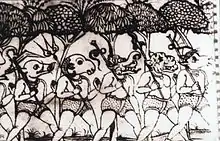
Asura, in the earliest hymns of the Rigveda, originally meant any supernatural spirit, either good or bad. Since the /s/ of the Indic linguistic branch is cognate with the /h/ of the Early Iranian languages, the word Asura, representing a category of celestial beings. Ancient Hinduism tells that Devas (also called suras) and Asuras are half-brothers, sons of the same father Kashyapa; although some of the Devas, such as Varuna, are also called Asuras. Later, during Puranic age, Asura and Rakshasa came to exclusively mean any of a race of anthropomorphic, powerful, possibly evil beings. Daitya (lit. sons of the mother "Diti"), Maya Danava, Rakshasa (lit. from "harm to be guarded against"), and Asura are incorrectly translated into English as "demon".
In post-Vedic Hindu scriptures, pious, highly enlightened Asuras, such as Prahlada and Vibhishana, are not uncommon. The Asura are not fundamentally against the gods, nor do they tempt humans to fall. Many people metaphorically interpret the Asura as manifestations of the ignoble passions in the human mind and as symbolic devices. There were also cases of power-hungry Asuras challenging various aspects of the gods, but only to be defeated eventually and seek forgiveness.
Evil spirits
Hinduism advocates the reincarnation and transmigration of souls according to one's karma. Souls (Atman) of the dead are adjudged by the Yama and are accorded various purging punishments before being reborn. Humans that have committed extraordinary wrongs are condemned to roam as lonely, often mischief mongers, spirits for a length of time before being reborn. Many kinds of such spirits (Vetalas, Pishachas, Bhūta) are recognized in the later Hindu texts.
Iranian demons
Zoroastrianism
Evil spirits are the creation of the evil principle Ahriman in Zoroastrian cosmology, commonly referred to as Daeva. The first six archdemons are produced by Ahriman in direct opposition to the holy immortals created by Ahura Mazda the principle of good. This six archdemons (or seven if Ahriman is included) give existence to uncountable malevolent daeva; the Zorastrian demons. They are the embodiment of evil, causing moral imperfection, destroy, kill and torment the wicked souls in the afterlife.[81] Some demons are related to specific vices. Humans in the state of such sin might be possessed by a corresponding demon:[82]
- Anger (Kheshm)
- Laziness (Bushyansta)
- Envy (Areshk)
- Gossip (Spazga)
- Grief (Akoman)
Manichaeism
In Manichaean mythology demons had a real existence, as they derived from the Kingdom of Darkness, they were not metaphors expressing the absence of good nor are they fallen angels, that means they are not originally good, but entities purely evil. The demons came into the world after the Prince of Darkness assaulted the Realm of Light. The demons ultimately failed their attack and ended up imprisoned in the structures and matter of the contemporary world.[83] Lacking virtues and being in constant conflict with both the divine creatures and themselves, they are inferior to the divine entities and overcome by the divine beings at the end of time. They are not sophisticated or inventive creatures, but only driven by their urges.[84]
Simultaneously, the Manichaean concept of demons remains abstract and is closely linked to ethical aspects of evil that many of them appear as personified evil qualities such as:[84]
- Greed (desire for wealth)
- Wrath (desire for destruction)
- Envy
- Grief
The Watcher, another group of demonic entities, known from the Enochian writings, appear in the canonical Book of Giants. The Watchers came into existence after the demons were chained up in the sky by Living Spirit. Later, outwitted by Third Messenger, they fall to earth, there they had intercourse with human women and beget the monstrous Nephilim. Thereupon they establish a tyrannical rule on earth, suppressing mankind, until they are defeated by the angels of punishment, setting an end to their rule.[85]
Native North American demons
Wendigo
The Algonquian people traditionally believe in a spirit called a wendigo. The spirit is believed to possess people who then become cannibals. In Athabaskan folklore, there is a belief in wechuge, a similar cannibal sprit.
Wicca
According to Rosemary Ellen Guiley, "Demons are not courted or worshipped in contemporary Wicca and Paganism. The existence of negative energies is acknowledged."[86]
Modern interpretations

Psychologist Wilhelm Wundt remarked that "among the activities attributed by myths all over the world to demons, the harmful predominate, so that in popular belief bad demons are clearly older than good ones."[87] Sigmund Freud developed this idea and claimed that the concept of demons was derived from the important relation of the living to the dead: "The fact that demons are always regarded as the spirits of those who have died recently shows better than anything the influence of mourning on the origin of the belief in demons."[88]
M. Scott Peck, an American psychiatrist, wrote two books on the subject, People of the Lie: The Hope For Healing Human Evil[89] and Glimpses of the Devil: A Psychiatrist's Personal Accounts of Possession, Exorcism, and Redemption.[90] Peck describes in some detail several cases involving his patients. In People of the Lie he provides identifying characteristics of an evil person, whom he classified as having a character disorder. In Glimpses of the Devil Peck goes into significant detail describing how he became interested in exorcism in order to debunk the myth of possession by evil spirits – only to be convinced otherwise after encountering two cases which did not fit into any category known to psychology or psychiatry. Peck came to the conclusion that possession was a rare phenomenon related to evil and that possessed people are not actually evil; rather, they are doing battle with the forces of evil.[91]
Although Peck's earlier work was met with widespread popular acceptance, his work on the topics of evil and possession has generated significant debate and derision. Much was made of his association with (and admiration for) the controversial Malachi Martin, a Roman Catholic priest and a former Jesuit, despite the fact that Peck consistently called Martin a liar and a manipulator.[92][93] Richard Woods, a Roman Catholic priest and theologian, has claimed that Dr. Peck misdiagnosed patients based upon a lack of knowledge regarding dissociative identity disorder (formerly known as multiple personality disorder) and had apparently transgressed the boundaries of professional ethics by attempting to persuade his patients into accepting Christianity.[92] Father Woods admitted that he has never witnessed a genuine case of demonic possession in all his years.[94][95][96]
According to S. N. Chiu, God is shown sending a demon against Saul in 1 Samuel 16 and 18 in order to punish him for the failure to follow God's instructions, showing God as having the power to use demons for his own purposes, putting the demon under his divine authority.[97] According to the Britannica Concise Encyclopedia, demons, despite being typically associated with evil, are often shown to be under divine control, and not acting of their own devices.[98]
See also
- Acheri
- Classification of demons
- Empusa
- Erinyes
- Folk devil
- Goblin
- Holy water#Protection against evil
- Imp
- List of fictional demons
- List of theological demons
- Mara
- Spiritual warfare
- Theistic Satanism
- Yaoguai
- Yokai
- Zlydzens
References
- Liddell, Henry George; Scott, Robert. "δαιμόνιον". A Greek–English Lexicon. Perseus.
- "Demon". Merriam-Webster Dictionary. Encyclopædia Britannica. Retrieved 12 April 2012.
- See, for example, the course synopsis and bibliography for "Magic, Science, Religion: The Development of the Western Esoteric Traditions" Archived November 29, 2014, at the Wayback Machine, at Central European University, Budapest.
- Fox, Robin Lane (1989). Pagans and Christians. p. 137.
- See the Medieval grimoire called the Ars Goetia.
- Boyce, 1987; Black and Rowley, 1987; Duchesne-Guillemin, 1988.
- Rita Lucarelli Demons (Benevolent and Malevolent Ucla Encyclopedia of egyptology 2010 p.3
- Rita Lucarelli Demons (Benevolent and Malevolent Ucla Encyclopedia of egyptology 2010 p. 2
- Siam Bhayro, Catherine Rider Demons and Illness from Antiquity to the Early-Modern Period BRILL 2017 ISBN 978-9-004-33854-8 p. 53
- Rita Lucarelli Demons (Benevolent and Malevolent Ucla Encyclopedia of egyptology 2010 p. 3
- Siam Bhayro, Catherine Rider Demons and Illness from Antiquity to the Early-Modern Period BRILL 2017 ISBN 978-9-004-33854-8 p. 55
- Rita Lucarelli Demons (Benevolent and Malevolent Ucla Encyclopedia of egyptology 2010 p. 4
- Dorian Gieseler Greenbaum The Daimon in Hellenistic Astrology: Origins and Influence BRILL 2015 ISBN 9789004306219 p. 120
- Black & Green 1992, p. 180.
- Black & Green 1992, p. 85.
- Black & Green 1992, pp. 85–86.
- Black & Green 1992, p. 86.
- Black & Green 1992, p. 116.
- Black & Green 1992, pp. 115–116.
- Black & Green 1992, p. 147.
- Black & Green 1992, p. 148.
- Black & Green 1992, pp. 147–148.
- Black & Green 1992, p. 173.
- George 1999, p. 225.
- Hirsch, Emil G.; Gottheil, Richard; Kohler, Kaufmann; Broydé, Isaac (1906). "Demonology". Jewish Encyclopedia.
- See Delitzsch, Assyrisches Handwörterbuch. pp. 60, 253, 261, 646; Jensen, Assyr.-Babyl. Mythen und Epen, 1900, p. 453; Archibald Sayce, l.c. pp. 441, 450, 463; Lenormant, l.c. pp. 48–51.
- "Demons & Demonology". jewishvirtuallibrary.org. The Gale Group. Retrieved 21 March 2015.
- Bar-Hayim, David. "Do Jews Believe in Demons and Evil Spirits?-Interview with Rabbi David Bar-Hayim". www.youtube.com. Tora Nation Machon Shilo. Retrieved 20 March 2015.
- "DEMONOLOGY - JewishEncyclopedia.com". www.jewishencyclopedia.com.
- Benjamin W. McCraw, Robert Arp Philosophical Approaches to Demonology Routledge 2017 ISBN 978-1-315-46675-0 page 9
- Plaut, W. Gunther (2005). The Torah: A Modern Commentary. Union for Reform Judaism. p. 1403.
- compare Isaiah 38:11 with Job 14:13; Psalms 16:10, 49:16, and 139:8
- Isaacs, Ronald H. (1998). Ascending Jacob's Ladder: Jewish Views of Angels, Demons, and Evil Spirits. Jason Aronson. p. 96. ISBN 978-0-7657-5965-8. Retrieved 10 September 2014.
- Bellum Judaeorum vii. 6, § 3
- "Antiquities" viii. 2, § 5
- García, Martínez Florentino. The Dead Sea Scrolls Translated: The Qumran Texts in English. Leiden: E.J. Brill, 1994. Print.
- Florentino Martinez Garcia, Magic in the Dead Sea Scrolls: The Metamorphosis of Magic: From Late Antiquity to the Early Modern Period, compilers Jan Bremmer and Jan R. Veenstra (Leuven: Peeters, 2003).
- Frey, J. (1984). "Different patterns of dualistic thought in the Qumran library". Legal Texts And Legal Issues. p. 287.
- Nickelsburg, George. Jewish Literature between the Bible and the Mishna.
- Frey (1984), p. 278.
- Nickelsburg, p. 147.
- Dead Sea Scrolls 1QS III 20–25
- Martin, Dale Basil (2010). "When did Angels Become Demons?". Journal of Biblical Literature. 129 (4): 657–677. doi:10.2307/25765960. JSTOR 25765960.
- Bar-Hayim, David (HaRav). "Do Jews Believe in Demons and Evil Spirits?". Machon Shilo. Retrieved 20 March 2015.
- Geoffrey W. Dennis The Encyclopedia of Jewish Myth, Magic and Mysticism: Second Edition Llewellyn Worldwide 2016 ISBN 978-0-738-74814-6
- Pettigrove, Cedrick (2017-01-16). The Esoteric Codex: Supernatural Legends. Lulu.com. ISBN 9781329053090.
- (Targ. Yer. to Deuteronomy xxxii. 24 and Numbers vi. 24; Targ. to Cant. iii. 8, iv. 6; Eccl. ii. 5; Ps. xci. 5, 6.)
- Targ. to Eccl. i. 13; Pes. 110a; Yer. Shek. 49b
- Pes. 112b; compare B. Ḳ. 21a
- "Hebrew Concordance: ū·śə·'î·rîm – 1 Occurrence". Biblesuite.com. Retrieved 2014-03-12.
- "1140. daimonion". Biblos.com. Retrieved 20 March 2015.
- Dan Burton and David Grandy, Magic, Mystery, and Science: The Occult in Western Civilization (Indiana University Press, 2003), p. 120 online.
- Illes, Judika (2009). Encyclopedia of Spirits: The Ultimate Guide to the Magic of Fairies, Genies, Demons, Ghosts, Gods & Goddesses. HarperCollins. p. 902. ISBN 9780062046093.
- Harris, Stephen L., Understanding the Bible. Palo Alto: Mayfield. 1985. It is considered one of the pseudepigrapha by Protestant, Roman Catholic, and Eastern Orthodox Churches
- Moshe Berstein, Angels at the Aqedah: A Study in the Development of a Midrashic Motif, (Dead Sea Discoveries, 7, 2000), 267.
- Jubilees 10:7–9
- Sara Elizabeth Hecker. Dueling Demons: Mikhail Vrubel’s Demon Seated and Demon Downcast. Art in Russia, 2012-05-08. Archived 2015-06-15 at the Wayback Machine. Art in Russia, the School of Russian and Asian Studies, 2012
- Hanneken Henoch, T. R. (2006). ANGELS AND DEMONS IN THE BOOK OF JUBILEES AND CONTEMPORARY APOCALYPSES. pp. 11–25.
- VanderKam, James C. (1999). THE ANGEL STORY IN THE BOOK OF JUBILEES IN: Pseudepigraphic Perspectives : The Apocrypha And Pseudepigrapha In Light Of The Dead Sea Scrolls. pp. 151–170.
- Vermes, Geza (2011). The complete Dead Sea scrolls in English. London: Penguin. p. 375.
- Victor I. Ezigbo Re-imagining African Christologies: Conversing with the Interpretations and Appropriations of Jesus in Contemporary African Christianity Wipf and Stock Publishers 2010 ISBN 978-1-630-87803-0 page 235
- Juanita Feros Ruys Demons in the Middle Ages ISD LLC 2017 ISBN 978-1-942-40136-0
- Maijastina Kahlos Debate and Dialogue: Christian and Pagan Cultures C. 360–430 Routledge 2016 ISBN 978-1-317-15436-5 page 174
- van der Toorn, K.; Becking, B.; van der Horst, P. W. (1999), "Demon". In Dictionary of Deities and Demons in The Bible, Second Extensively Revised Edition, pp. 235–240, William B. Eerdmans Publishing Company, ISBN 0-8028-2491-9
- Orlov, Andrei A. (2015). Divine Scapegoats: Demonic Mimesis in Early Jewish Mysticism. New York: SUNY Press. p. 4. ISBN 9781438455846.
- Exorcism, Sancta Missa – Rituale Romanum, 1962, at sanctamissa.org, Copyright 2007. Canons Regular of St. John Cantius
- Hansen, Chadwick (1970), Witchcraft at Salem, p. 132, Signet Classics, Library of Congress Catalog Card Number: 69-15825
- Modica, Terry Ann (1996), Overcoming The Power of The Occult, p. 31, Faith Publishing Company, ISBN 1-880033-24-0
- Corapi, John (February 9, 2004). "Angels and Demons – Facts not Fiction". fathercorapi.com. Archived from the original on 2004-04-05.
- Charles Mathewes Understanding Religious Ethics John Wiley & Sons ISBN 978-1-405-13351-7. p. 249
- Travis Zadeh Commanding Demons and Jinn: The Sorcerer in Early Islamic Thought Wiesbaden: Harrassowitz Verlag, 2014 p-142-149
- Teuma, E. (1984). More on Qur'anic jinn. Melita Theologica, 39(1–2), 37–45.
- Abu l-Lait as-Samarqandi's Comentary on Abu Hanifa al-Fiqh al-absat Introduction, Text and Commentary by Hans Daiber Islamic concept of Belief in the 4th/10th Century Institute for the Study of Languages and Cultures of Asia and Africa p. 243
- Asa Simon Mittman, Peter J. Dendle The Ashgate Research Companion to Monsters and the Monstrous, Routledge 24.02.2017, ISBN 978-1-351-89431-9
- Robert Lebling Legends of the Fire Spirits: Jinn and Genies from Arabia to Zanzibar I.B.Tauris 2010 ISBN 978-0-857-73063-3 page 141
- Pedram Khosronejad THE PEOPLE OF THE AIR HEALING AND SPIRIT POSSESSION IN SOUTH OF IRAN In: Shamanism and Healing Rituals in Contemporary Islam and Sufism, T.Zarcone (ed.) 2011, I.B.Tauris
- Gerda Sengers Women and Demons: Cultic Healing in Islamic Egypt Brill, 2003 ISBN 978-9-004-12771-5
- Gerhard Doerfer, Wolfram Hesche Türkische Folklore-Texte aus Chorasan Otto Harrassowitz Verlag, 1998 ISBN 978-3-447-04111-9 p. 62 (German)
- Smith, Peter (2008). An Introduction to the Baha'i Faith. Cambridge: Cambridge University Press. p. 112. ISBN 978-0-521-86251-6.
- A. E. Waite, The Book of Black Magic, (Weiser Books, 2004).
- S. A. Nigosian, Solomon Alexander Nigosian The Zoroastrian Faith: Tradition and Modern Research McGill-Queen's Press - MQUP, 1993 ISBN 9780773511446 p. 86-88
- Fereshteh Davaran Continuity in Iranian Identity: Resilience of a Cultural Heritage Routledge, 26.02.2010 ISBN 9781134018314 p. 124-130
- Willis Barnstone, Marvin Meyer The Gnostic Bible: Revised and Expanded Edition Shambhala Publications 2009 ISBN 978-0-834-82414-0 page 575-577
- http://www.iranicaonline.org/articles/manicheism-pandaemonium
- http://www.iranicaonline.org/articles/giants-the-book-of
- Guiley, Rosemary (2008). The Encyclopedia of Witches, Witchcraft and Wicca. p. 95.
- Freud (1950), p. 65, quoting Wundt (1906, 129).
- Freud (1950)
- Peck, M. S. (1983). People of the Lie: The Hope For Healing Human Evil.
- Peck, M. S. (2005). Glimpses of the Devil: A Psychiatrist's Personal Accounts of Possession, Exorcism, and Redemption.
- The exorcist, an interview with M. Scott Peck by Rebecca Traister published in Salon Archived 2005-12-19 at the Wayback Machine
- The devil you know, National Catholic Reporter, April 29, 2005, a commentary on Glimpses of the Devil by Richard Woods
- The Patient Is the Exorcist, an interview with M. Scott Peck by Laura Sheahen
- "Dominican Newsroom". Archived from the original on August 29, 2012.
- "RichardWoodsOP.net". RichardWoodsOP.net. Archived from the original on 2013-12-28. Retrieved 2014-03-12.
- Haarman, Susan (2005-10-25). "BustedHalo.com". BustedHalo.com. Retrieved 2014-03-12.
- Chiu, S. N. (2000). "Historical, Religious, and Medical Perspectives of Possession Phenomenon". Hong Kong Journal of Psychiatry. 10 (1).
- "Demon" in Britannica Concise Encyclopedia,
Sources
- Freud, Sigmund (1950). Totem and Taboo:Some Points of Agreement between the Mental Lives of Savages and Neurotics. Translated by Strachey. New York: W. W. Norton & Company. ISBN 978-0-393-00143-3.
- Wundt, W. (1906). Mythus und Religion, Teil II (Völkerpsychologie, Band II). Leipzig.
- Castaneda, Carlos (1998). The Active Side of Infinity. HarperCollins NY ISBN 978-0-06-019220-4
- Hughes, Thomas Patrick (1995). Dictionary of Islam. Asian Educational Services. ISBN 978-8-120-60672-2.
Further reading
- Oppenheimer, Paul (1996). Evil and the Demonic: A New Theory of Monstrous Behavior. New York: New York University Press. ISBN 978-0-8147-6193-9.
- Walton, John H., and J. Harvey Walton. 2019. Demons and Spirits in Biblical Theology: Reading the Biblical Text in its Cultural and Literary Context.
- Catholic
- Baglio, Matt (2009). The Rite: The Making of a Modern Exorcist. Doubleday Religion. ISBN 978-0-385-52270-0.
- Amorth, Gabriele (1999). An Exorcist Tells His Story. Ignatius Press. ISBN 0-89870-710-2.
External links
 Quotations related to Demon at Wikiquote
Quotations related to Demon at Wikiquote The dictionary definition of δαίμων at Wiktionary
The dictionary definition of δαίμων at Wiktionary The dictionary definition of demon at Wiktionary
The dictionary definition of demon at Wiktionary Media related to Demons at Wikimedia Commons
Media related to Demons at Wikimedia Commons- Catechism of the Catholic Church: Hyperlinked references to demons in the online Catechism of the Catholic Church
- Dictionary of the History of Ideas: Demonology
- Profile of William Bradshaw, American demonologist Riverfront Times, St. Louis, Missouri, USA. August 2008.